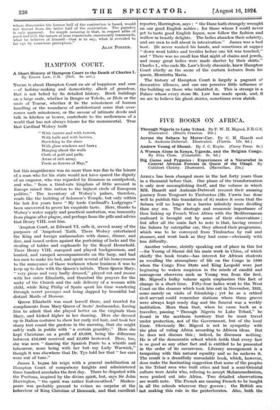HAMPTON COURT.
A Short History of Hampton Court to the Death of Charles I. By Ernest Law, C.B. (Bell. 6s. net.)
THERE is about Hampton Court an air of happiness and ease —of holiday-making and domesticity, albeit of grandeur, that is not belied by its detailed history. Brick buildings on a large scale, whether in Bruges or Toledo, or Blois or the oasis of Tozeur, whether it be the minuteness of human handling or the roundness of architectural sense that over- comes such minuteness, or the savour of intimate deeds and talk in kitchen or bower, contribute to the mellowness of a world that has not always leisure for the monumental. True that Cardinal Wolsey built "With turrets and with towers, With halls and with bowers, Stretching to the stars With glass windows and bars ; Hanging about the walls Cloth of gold and palls, Arras of rich array, Fresh as flowers of May,"
but this magnificence was no more than was due to the leisure of a man who for his state would not have spared the dignity of an emperor, who was regarded by Erasmus as omnipotent, and who, "from a third-rate kingdom of little account in Europe raised this nation to the highest circle of European politics." The inventory of Wolsey's palace, therefore, reads like the building of Solomon's Temple, but only within the last few years have "My lorde Cardinall's Lodgynges " been uncovered to prove his exquisite taste. Here, thanks to Wolsey's water supply and practical sanitation, was immunity from plague after plague, and perhaps from the pills and advice that Henry VIII. sent him.
'Ampton Court, as Edward VI. calls it, served many of the purposes of 'Ampstead 'Eath. There Wolsey entertained the King and foreign ambassadors with dance, dinner, and dice, and issued orders against the purloining of locks and the stealing of tables and cupboards by the Royal Household. There Henry VIII. masqued and played backgammon, and hunted, and vamped accompaniments on the harp, and had ten men to make his bed, and spent several of his honeymoons to the annoyance of those workmen whose business it was to keep up to date with the Queen's initials. There Queen Mary, "very pious and very badly dressed," played cat and mouse with her sister Elizabeth, and thumbed the prayers for the unity of the Church and the safe delivery of a woman with child, while King Philip of Spain spent his time wandering through secret passages and being slapped by beautiful but distant Maids of Honour.
Queen Elizabeth was most herself there, and trawled for compliments from Mary Queen of Scots' Ambassador, forcing him to admit that she played better on the virginals than Mary, and kicked higher in her dancing. Here she dressed up in Italian costume to show her curly red hair, and took her sharp trot round the gardens in the morning, that she might safely walk in public with "a certain grandity." Here she kept Christmas on a profit of 28,000, being the difference between 110,000 received and 12,000 bestowed. Here, too, she was seen "dancing the Spanish Panic to a whistle and taboureur, none being with her but - my Lady Warwick," though it was elsewhere that Dr. Tye told her that "her ears were out of tune."
James I. began his reign with a general mobilization at Hampton Court of compulsory knights and administered three hundred accolades the first day. There he disputed with the Puritans, inspired by the divine spirit, but, says Sir John Harrington, "the spirit was rather foul-mouthed." Shakes- peare was probably present to evince no surprise at the behaviour of King Christian of Denmark, and that excellent
reporter, Harrington, says : "the Dane hath strangely wrought on our good English nobles ; for those whom I could never get to taste good English liquor, now follow the fashion and wallow in beastly delights. The ladies abandon their sobriety, and are seen to roll about in intoxication." James was a bad host. He never washed his hands, and sometimes at supper "down went tables and trestles before one bit was touched," and " There was no small loss that night of chains and jewels, and many great ladies were made shorter by their skirts." Charles I., who ends Mr. Law's lively chronicle, knew Hampton Court chiefly as the scene of the curtain lectures from his queen, Henrietta Maria.
The history of Hampton Court is largely a pageant of decorative idleness, and one can perceive little influence of the building on those who inhabited it. This is strange in a Palace whose every stone Mr. Law has made speak, and, if we are to believe his ghost stories, sometimes even shriek.


































 Previous page
Previous page